Assessment of Charge Initiation Techniques Effect on Blast Fragmentation and Environmental Safety: An Application of WipFrag Software
Abstract
:1. Introduction
2. Materials and Methods
3. Results
3.1. Fragmentation Analysis Results
3.2. Fragmentation Result for NONEL Blasting
3.3. Fragmentation Result for Electric Blasting
3.4. Fragmentation Assessment Results
3.5. Blast-Induced Impact Result
3.5.1. Comparison between the Two Initiation Techniques
3.5.2. Regression Model for Blast Impact Prediction
3.6. WipFrag Software Spec Function and Chart Size Classifier Results
3.6.1. Nonelectric Blast Result Production Assessment
3.6.2. Electric Blast Result Production Assessment
4. Discussion
5. Conclusions
- The study result revealed that electric detonation produces high percentages of fines compared with the WipFrag analysis result from nonelectric detonator blasting.
- The finding revealed that electric detonation techniques generate high percentages of optimum-size material for 80% of the overall blast rounds compared with the company’s primary crusher inlet size range (316 mm and 215 mm mesh).
- The average ground vibration and noise level for the nonelectric blasting rounds in the mine were 0.108 mm/s and 81.7 dB, respectively. The average ground vibration and decibel level for the six monitored electric blasting rounds were 0.76 mm/s and 92.5 dB, respectively. The results indicate that the blast-induced ground vibration (peak particle velocity) generated by all of the blast rounds for electric blast ranged from 0.4–1.2 mm/s and 80–105 dB, while that of the nonelectric blast round ranged from 0.05–0.2 mm/s and 72–95 dB. The obtained readings from the case study blast site were lower than the limits set by the Federal Environmental Protection Agency (FEPA) of 5.0 mm/s and 150 dB [45].
- The result revealed that the noise levels and ground vibrations were higher in electric blasting compared with nonelectric detonator blasting. Ground vibration variability with scaled distance was revealed to have a negative correlation. In addition, the peak particle velocity and noise level were revealed to decrease as the scaled distance increased.
- The WipFrag spec function indicates that 80% of the electric blast round results were on spec for 316 mm and 215 mm sieves, with mesh passing greater than 70% of the minimum benchmark set for all blast results.
- The authors’ future work will focus on applying the deep learning algorithm in WipFrag 4.0 to simulate more blast image analysis for better assessment. Moreover, the authors also plan to utilize the orthomosaic features in the new version to capture underlying particles and more fine materials in the muck pile. Future work will also consider comparing the WipFrag analysis with other image analysis software, such as Split Desktop, among others.
Author Contributions
Funding
Informed Consent Statement
Data Availability Statement
Acknowledgments
Conflicts of Interest
References
- Le Bas, M.J.; Spiro, B.; Xueming, Y. Oxygen, carbon and strontium isotope study of the Carbonatitic dolomite host of the Bayan Obo Fe-Nb-REE deposit, Inner Mongolia, N China. Mineral. Mag. 1997, 407, 531–541. [Google Scholar] [CrossRef]
- Taiwo, B.O.; Omotehinse, A.O. The economic potential of some metacarbonate rocks in Akoko-Edo, Edo state Nigeria. Appl. Earth Sci. 2022, 3, 167–178. [Google Scholar] [CrossRef]
- Dzikowski, T.J.; Cempírek, J.; Groat, L.A.; Dipple, G.M.; Giuliani, G. Origin of gem corundum in calcite marble: The Revelstoke occurrence in the Canadian Cordillera of British Columbia. Lithos 2014, 198, 281–297. [Google Scholar] [CrossRef]
- Winkler, E. Stone in Architecture: Properties, Durability; Springer Science & Business Media: Berlin/Heidelberg, Germany, 1997. [Google Scholar]
- Pitra, P.; De Waal, S.A. High-temperature, low-pressure metamorphism and development of prograde symplectites, Marble Hall Fragment, Bushveld Complex (South Africa). J. Metamorph. Geol. 2001, 3, 311–325. [Google Scholar]
- Hilson, G. Formalization bubbles: A blueprint for sustainable artisanal and small-scale mining (ASM) in sub-Saharan Africa. Extr. Ind. Soc. 2020, 7, 1624–1638. [Google Scholar] [CrossRef]
- Warra, A.A.; Prasad, M.N. Artisanal and small-scale gold mining waste rehabilitation with energy crops and native flora—A case study from Nigeria. In Bio-Geotechnologies for Mine Site Rehabilitation; Elsevier: Amsterdam, The Netherlands, 2018; pp. 473–491. [Google Scholar]
- Zhu, F.; Lu, G. A review of blast and impact of metallic and sandwich structures. Electron. J. Struct. Eng. 2007, 1, 92–101. [Google Scholar] [CrossRef]
- Nton, M.E. Report Submitted to the Honourable Minister Federal Ministry of Solid Minerals Development Abuja, FASD-2012-2016-FMMSD-Report.pdf. Available online: https://www.neiti.gov.ng/ (accessed on 22 February 2023).
- Kanchibotla, S.S.; Valery, W.; Morrell, S. Modelling fines in blast fragmentation and its impact on crushing and grinding. In Explo ‘99–A Conference on Rock Breaking; The Australasian Institute of Mining and Metallurgy: Kalgoorlie, Australia, 1999; pp. 137–144. [Google Scholar]
- Taiwo, B.O. Effect of charge load proportion and blast controllable factor design on blast fragment size distribution. J. Brill. Eng. 2022, 3, 46–58. [Google Scholar] [CrossRef]
- Jhanwar, J.C. Theory and practice of air-deck blasting in mines and surface excavations: A review. Geotech. Geol. Eng. 2011, 5, 651–663. [Google Scholar] [CrossRef]
- Deniz, V.; Deniz, O.T. The environmental effects of the air shock generated by blasting. Mugla J. Sci. Technol. 2017, 2, 166–170. [Google Scholar] [CrossRef]
- Jethro, M.A.; Shehu, S.A.; Kayode, T.S. Effect of Fragmentation on Loading at Obajana Cement Company Plc, Nigeria. Int. J. Sci. Eng. Res. 2016, 7, 608–620. [Google Scholar]
- Kinyua, E.M.; Jianhua, Z.; Kasomo, R.M.; Mauti, D.; Mwangangi, J. A review of the influence of blast fragmentation on downstream processing of metal ores. Miner. Eng. 2022, 186, 107743. [Google Scholar] [CrossRef]
- Dotto, M.S.; Pourrahimian, Y. Effects of Fragmentation Size Distribution on Truck-Shovel Productivity. In MOL Report Nine; University of Alberta: Edmonton, AB, Canada, 2018; pp. 335–342. [Google Scholar]
- Mackenzie, A.S. Cost of explosive—Do you evaluate it properly? Min. Congr. J. 1996, 32–41. [Google Scholar]
- Murlidhar, B.R.; Armaghani, D.J.; Mohamad, E.T. Intelligence prediction of some selected environmental issues of blasting: A review. Open Constr. Build. Technol. J. 2020, 14, 298–308. [Google Scholar] [CrossRef]
- Kumar, R.; Choudhury, D.; Bhargava, K. Determination of blast-induced ground vibration equations for rocks using mechanical and geological properties. J. Rock Mech. Geotech. Eng. 2016, 3, 341–349. [Google Scholar] [CrossRef]
- Hilson, G. Small-scale mining and its socio-economic impact in developing countries. In Natural Resources Forum; Blackwell Publishing Ltd.: Oxford, UK; Boston, MA, USA, 2002; Volume 26, pp. 3–13. [Google Scholar]
- Hilson, G. Small-scale mining in Africa: Tackling pressing environmental problems with improved strategy. J. Environ. Dev. 2002, 2, 149–174. [Google Scholar] [CrossRef]
- Jhon Gladious, J.; Janarthanan, R.; Preethivi, R.; Rajakumar, S.; Ramadoss, R. Nonel Initiation for Eco-Friendly Blasting. Int. J. Curr. Eng. Sci. Res. 2019, 6, 223–229. [Google Scholar]
- Maerz, N.H.; Palangio, T.C.; Franklin, J.A. WipFrag image based granulometry system. In Measurement of Blast Fragmentation; Routledge: Oxfordshire, UK, 2018; pp. 91–99. [Google Scholar]
- Kalyan, D.; Gopi, B.; Kumar, B.P.; Kumar, B.G.; Raju, G. A study on various surface blast initiation systems. Int. Res. J. Eng. Technol. 2021, 7, 2616–2618. [Google Scholar]
- Matyáš, R.; Pachman, J.; Matyáš, R.; Pachman, J. Introduction to Initiating Substances. In Primary Explosives; Springer: Berlin/Heidelberg, Germany, 2013; pp. 1–10. [Google Scholar]
- Stagg, M.S.; Engler, A.J. Measurement of Blast-Induced Ground Vibrations and Seismograph Calibration; US Department of the Interior, Bureau of Mines: Washington, DC, USA, 1980; Volume 8506. [Google Scholar]
- Siddiqui, F.I. Measurement of size distribution of blasted rock using digital image processing. Eng. Sci. 2009, 20, 81–93. [Google Scholar] [CrossRef]
- Blanco, J.A.S.; Singh, A.K. (Eds.) Measurement and Analysis of Blast Fragmentation; CRC Press: Boca Raton, FL, USA, 2012. [Google Scholar]
- Maerz, N.H.; Palangio, T.W. Post-muckpile, pre-primary crusher, automated optical blast fragmentation sizing. Fragblast 2004, 8, 119–136. [Google Scholar] [CrossRef]
- Maerz, N.H.; Palangio, T.C. WipFrag System II–Online Fragmentation Analysis. In Proceeding of the FRAGBLAST 6, Sixth International Symposium for Rock Fragmentation by Blasting, Johannesburg, South Africa, 8–12 August 1999; pp. 8–12. [Google Scholar]
- Faramarzi, F.; Farsangi, M.A.E.; Mansouri, H. Simultaneous investigation of blast induced ground vibration and airblast effects on safety level of structures and human in surface blasting. Int. J. Min. Sci. Technol. 2014, 5, 663–669. [Google Scholar] [CrossRef]
- Nateghi, R. Evaluation of blast induced ground vibration for minimizing negative effects on surrounding structures. Soil Dyn. Earthq. Eng. 2012, 43, 133–138. [Google Scholar] [CrossRef]
- Cardu, M.; Giraudi, A.; Oreste, P. A review of the benefits of electronic detonators. Rem Rev. Esc. Minas 2013, 66, 375–382. [Google Scholar] [CrossRef]
- Gupta, I.D.; Marwadi, S.C.; Tripathy, G.R.; Shirke, R.R. Environmental Impact of Blasting and Safety of Historic Structures. In Proceedings of the First National Symposium on Environmental Hydraulics, CWPRS, Pune, India, 24–26 June 1992; pp. 26–35. [Google Scholar]
- Kahriman, A.; Ozer, U.; Aksoy, M.; Karadogan, A.; Tuncer, G. Environmental impacts of bench blasting at Hisarcik Boron open pit mine in Turkey. Environ. Geol. 2006, 50, 1015–1023. [Google Scholar] [CrossRef]
- Vasović, D.; Kostić, S.; Ravilić, M.; Trajković, S. Environmental impact of blasting at Drenovac limestone quarry (Serbia). Environ. Earth Sci. 2014, 72, 3915–3928. [Google Scholar] [CrossRef]
- Pantelic, U.; Lilic, P.; Cvjetic, A.; Lilic, N. Environmental Noise Impact Assessment for Large-Scale Surface Mining Operations in Serbia. Sustainability 2023, 3, 1798. [Google Scholar] [CrossRef]
- Nateghi, R. Prediction of ground vibration level induced by blasting at different rock units. Int. J. Rock Mech. Min. Sci. 2011, 6, 899–908. [Google Scholar] [CrossRef]
- Ndibalema, A. Capturing economic benefits from blasting. In Proceedings of the Southern African Institute of Mining and Metallurgy: Surface Mining Conference, Johannesburg, South Africa, 5–8 August 2008; pp. 97–112. [Google Scholar]
- Rodríguez Díez, R.; Fernández, P.; Lombardía, C.; Bascompta, M.M. Analysis of blasting vibrations produced in a gold mine using the damage prevention abacus. In Proceedings of the 8th World Congresson Mechanical, Chemical, and Material Engineering (MCM’22), Prague, Czech Republic, 31 July–2 August 2022; International ASET Inc.: Orléans, ON, Canada, 2022. [Google Scholar]
- Wang, X.; Li, J.; Zhao, X.; Liang, Y. Propagation characteristics and prediction of blast-induced vibration on closely spaced rock tunnels. Tunn. Undergr. Space Technol. 2022, 123, 104416. [Google Scholar] [CrossRef]
- Mutinda, E.K.; Alunda, B.O.; Maina, D.K.; Kasomo, R.M. Prediction of rock fragmentation using the Kuznetsov-Cunningham-Ouchterlony model. J. S. Afr. Inst. Min. Metall. 2021, 3, 107–112. [Google Scholar] [CrossRef]
- Taiwo, B.O. Improvement of Small-Scale Dolomite Blasting Productivity: Comparison of Existing Empirical Models with Image Analysis 44 Software and Artificial Neural Network Models. J. Min. Environ. 2022, 3, 627–641. [Google Scholar]
- Prasad, S.; Choudhary, B.S.; Mishra, A.K. Effect of stemming to burden ratio and powder factor on blast induced rock fragmentation–a case study. In IOP Conference Series: Materials Science and Engineering; IOP Publishing: Bristol, UK, 2017; Volume 225, p. 012191. [Google Scholar]
- Afeni, T.B.; Osasan, S.K. Assessment of noise and ground vibration induced during blasting operations in an open pit mine—A case study on Ewekoro limestone quarry, Nigeria. Min. Sci. Technol. 2009, 19, 420–424. [Google Scholar] [CrossRef]
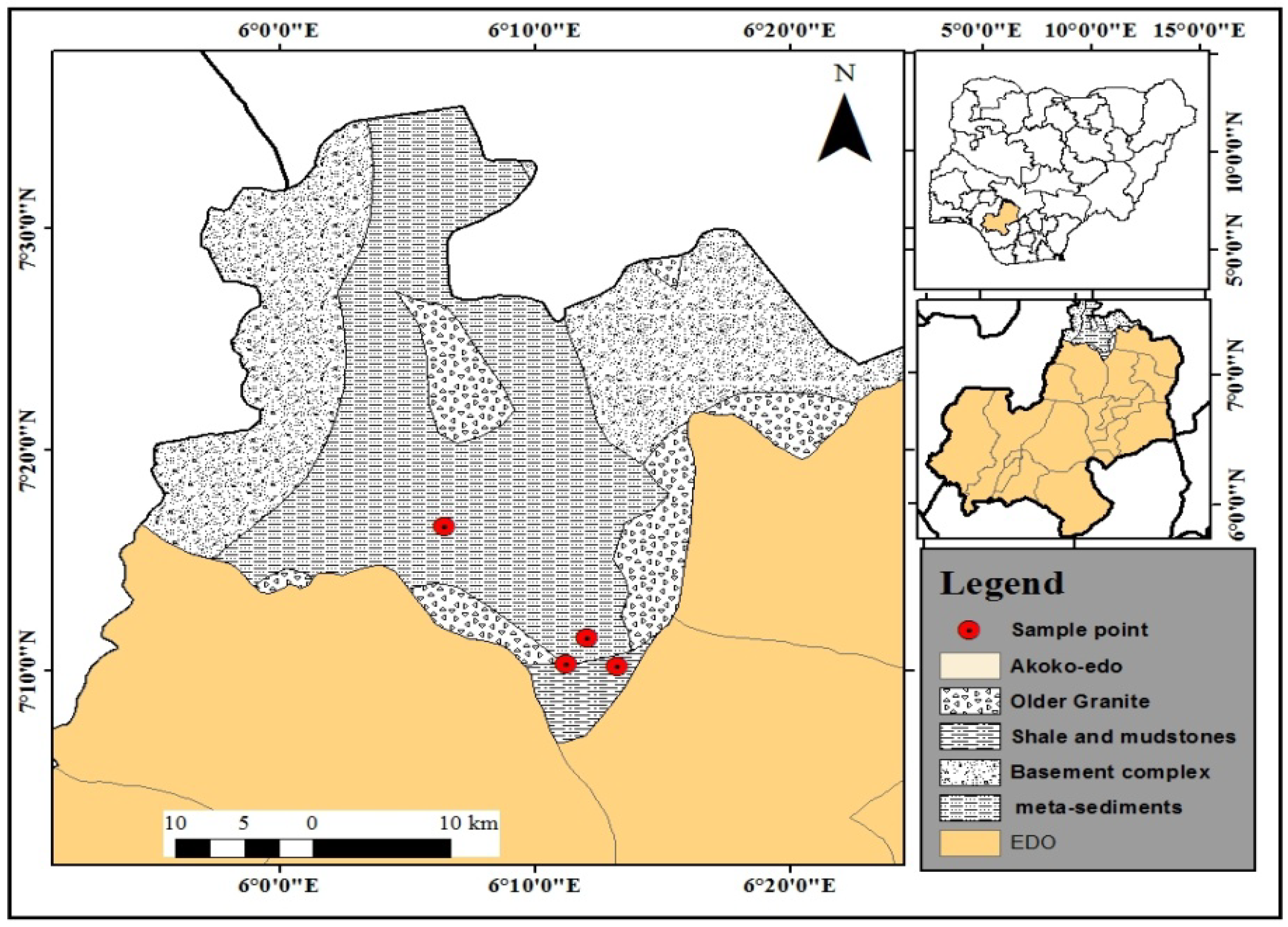
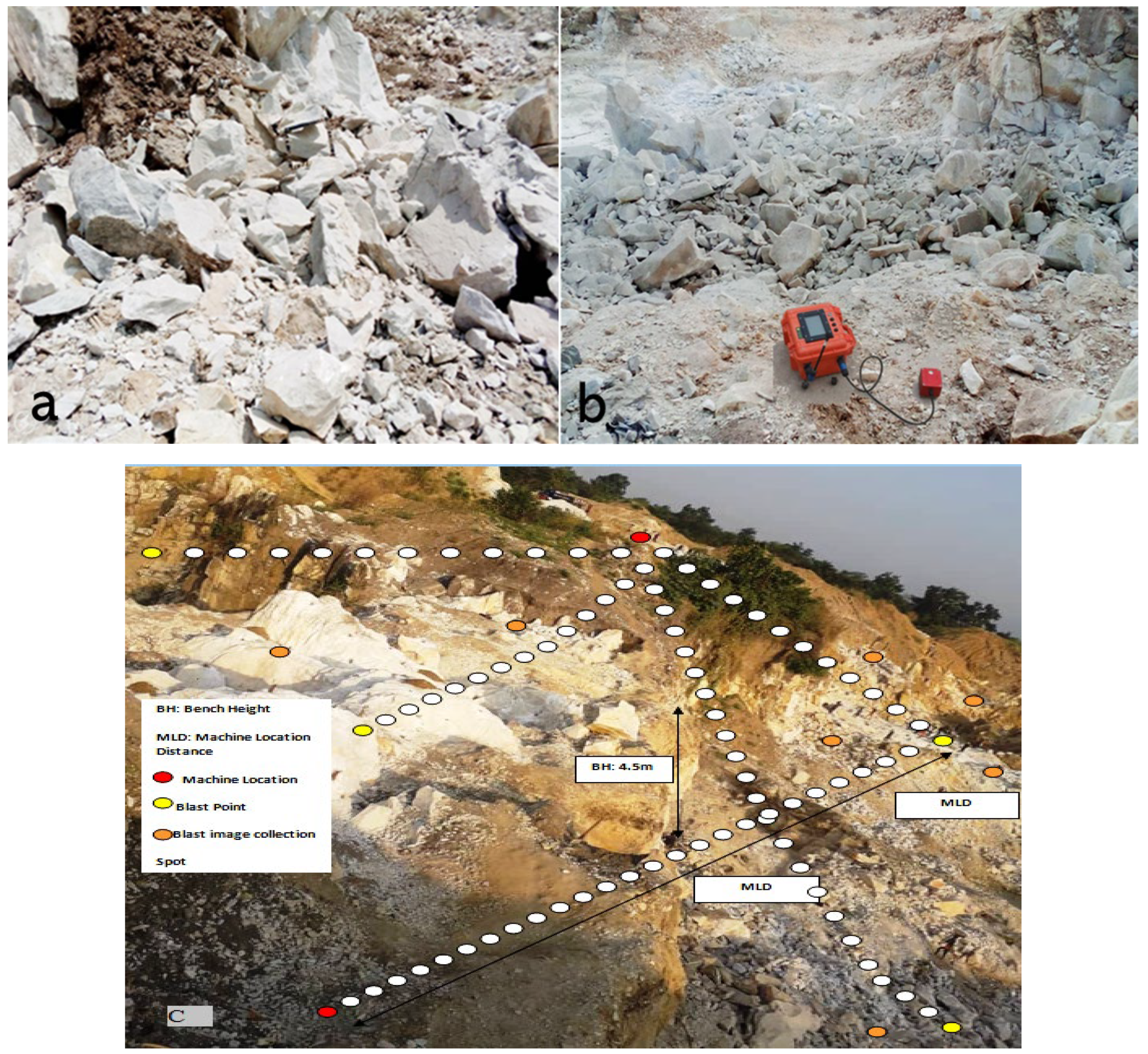
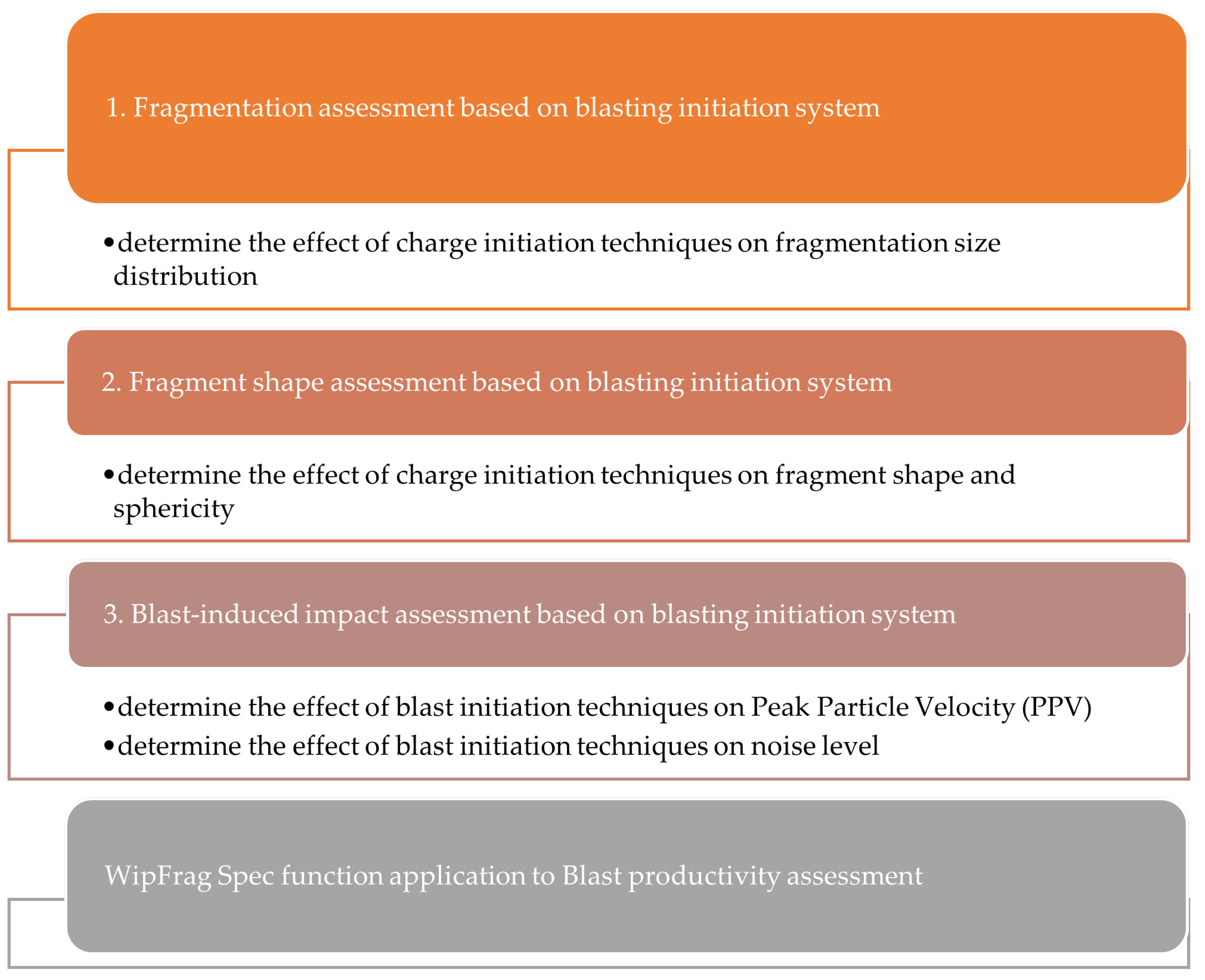


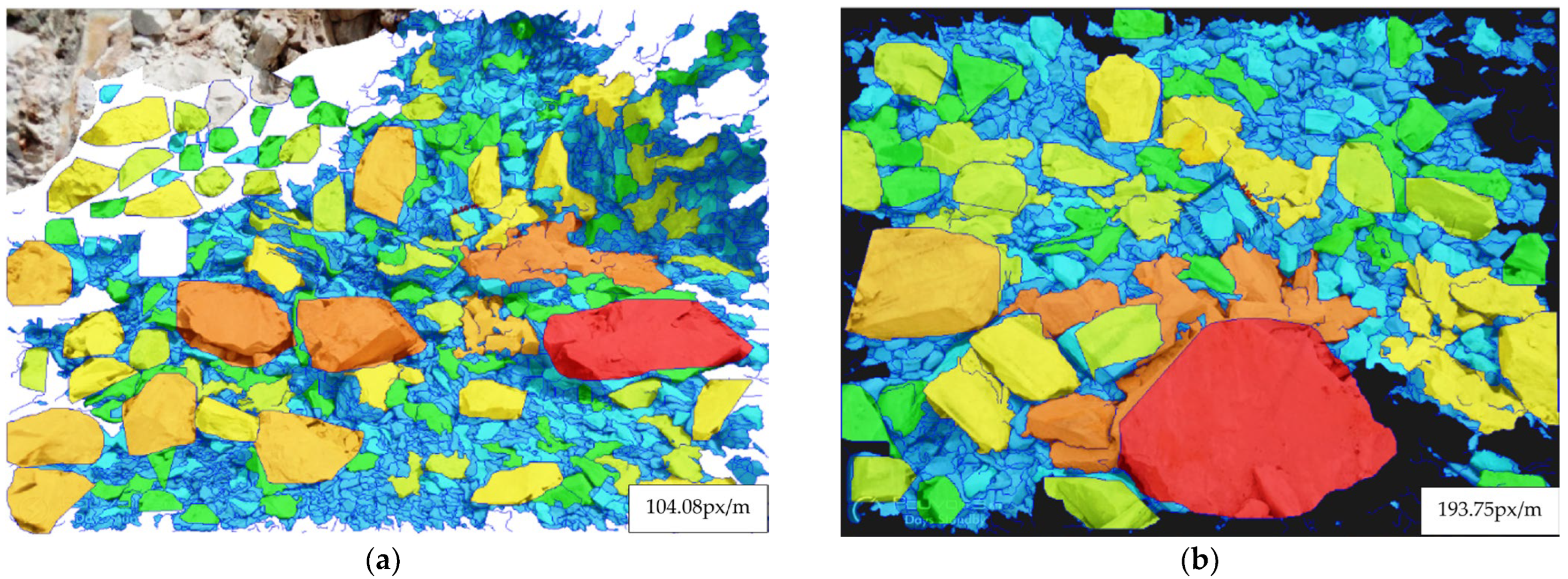
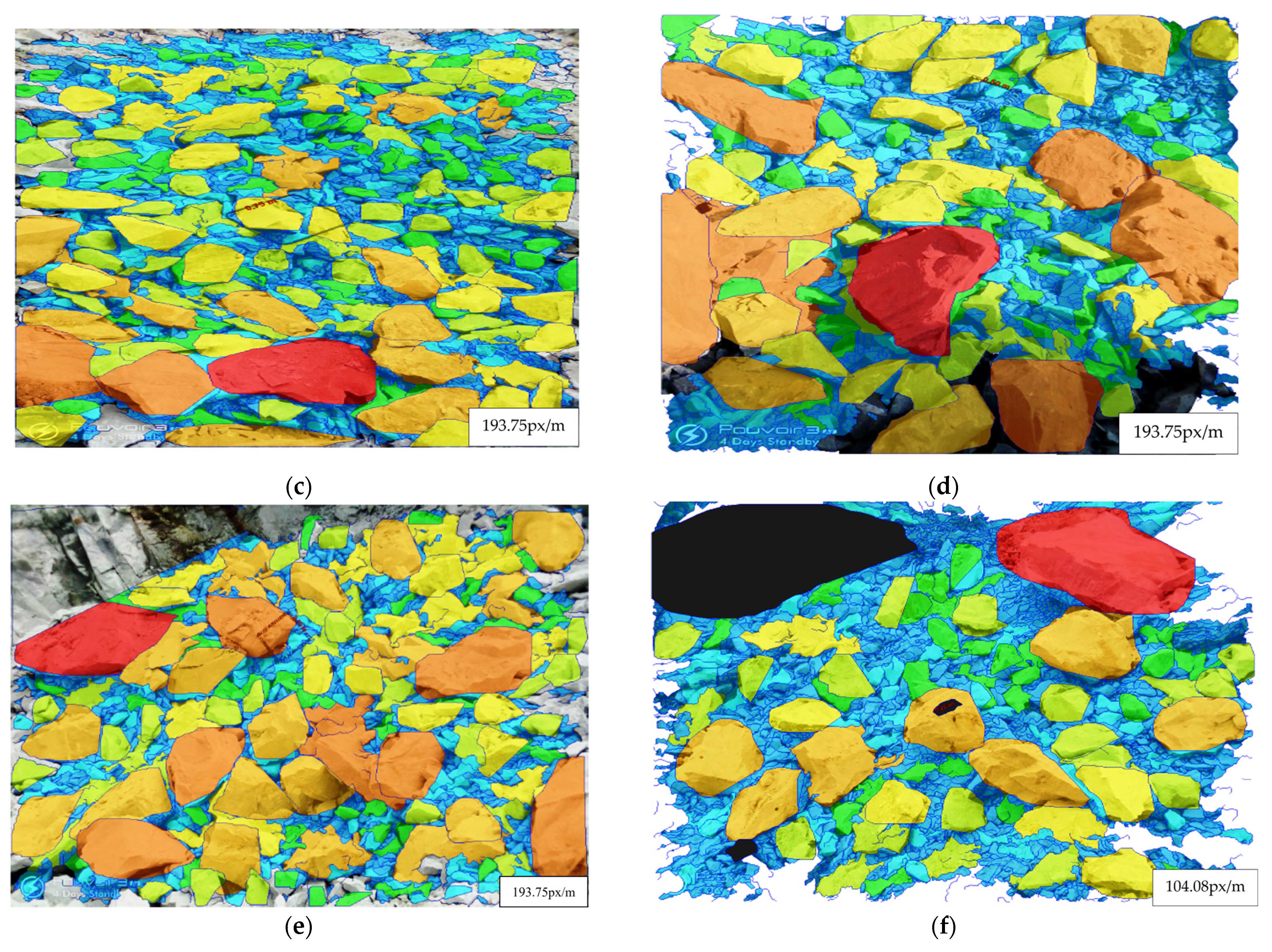
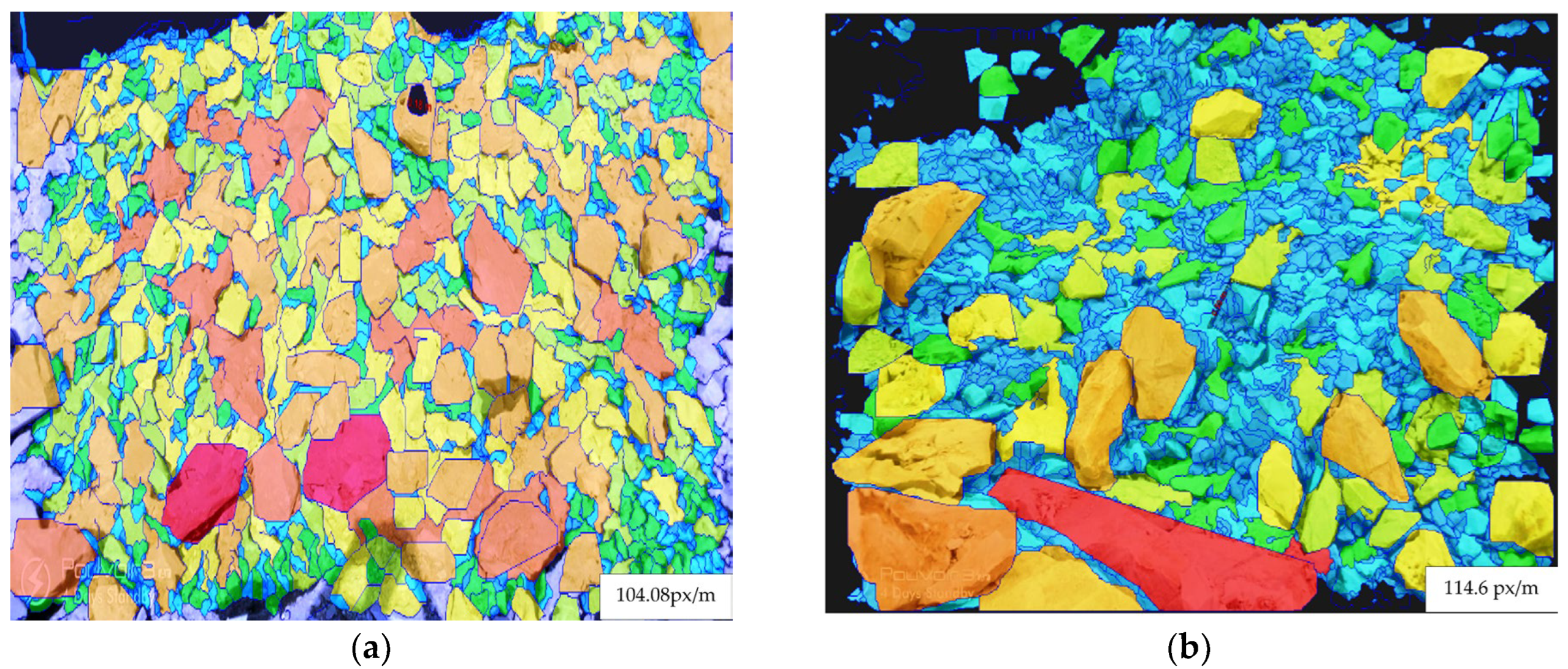

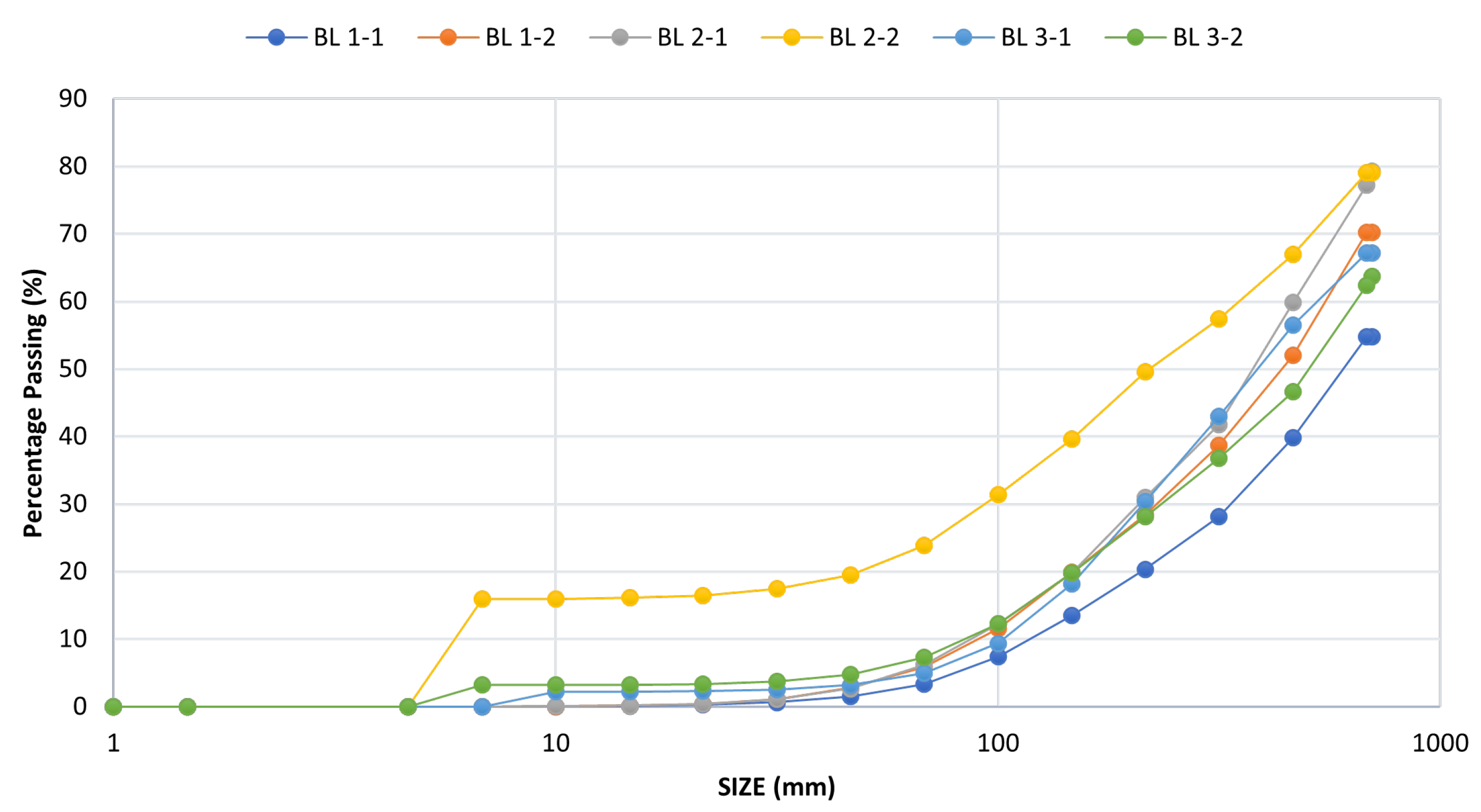

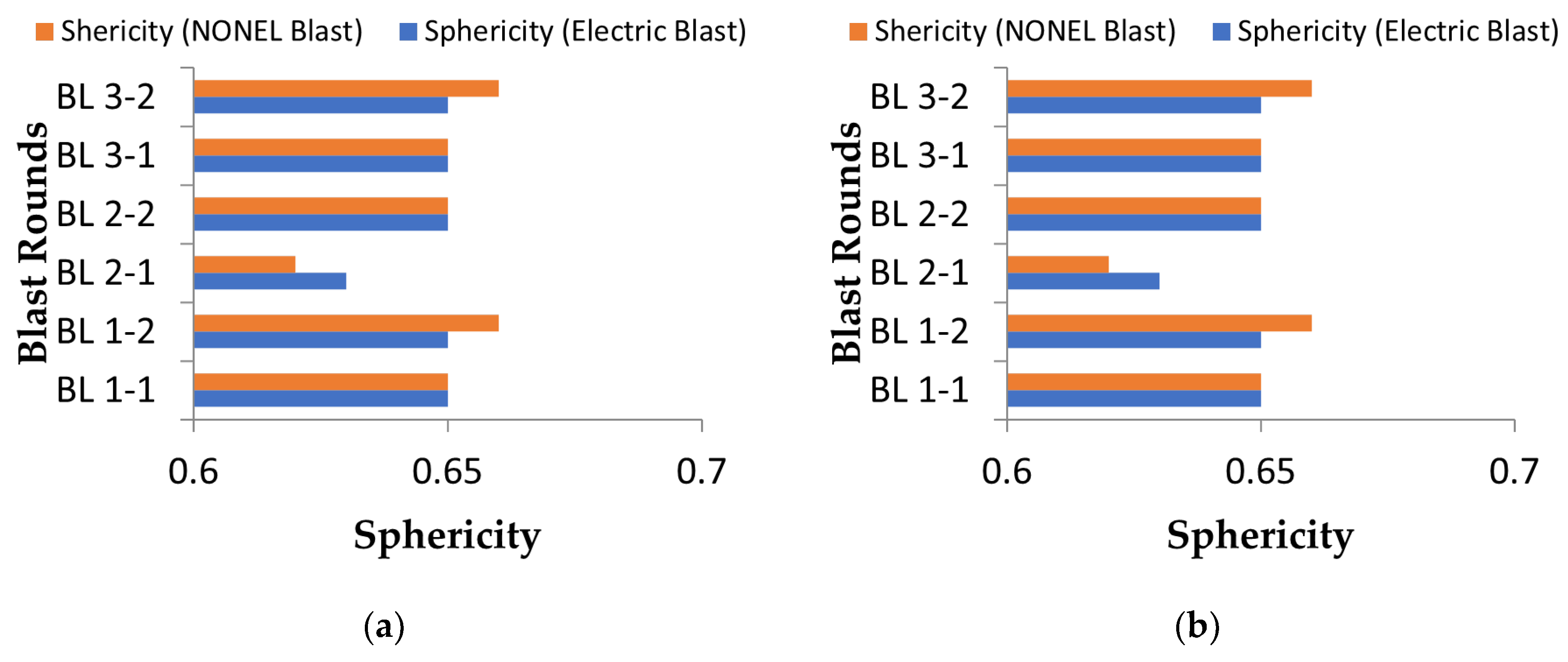
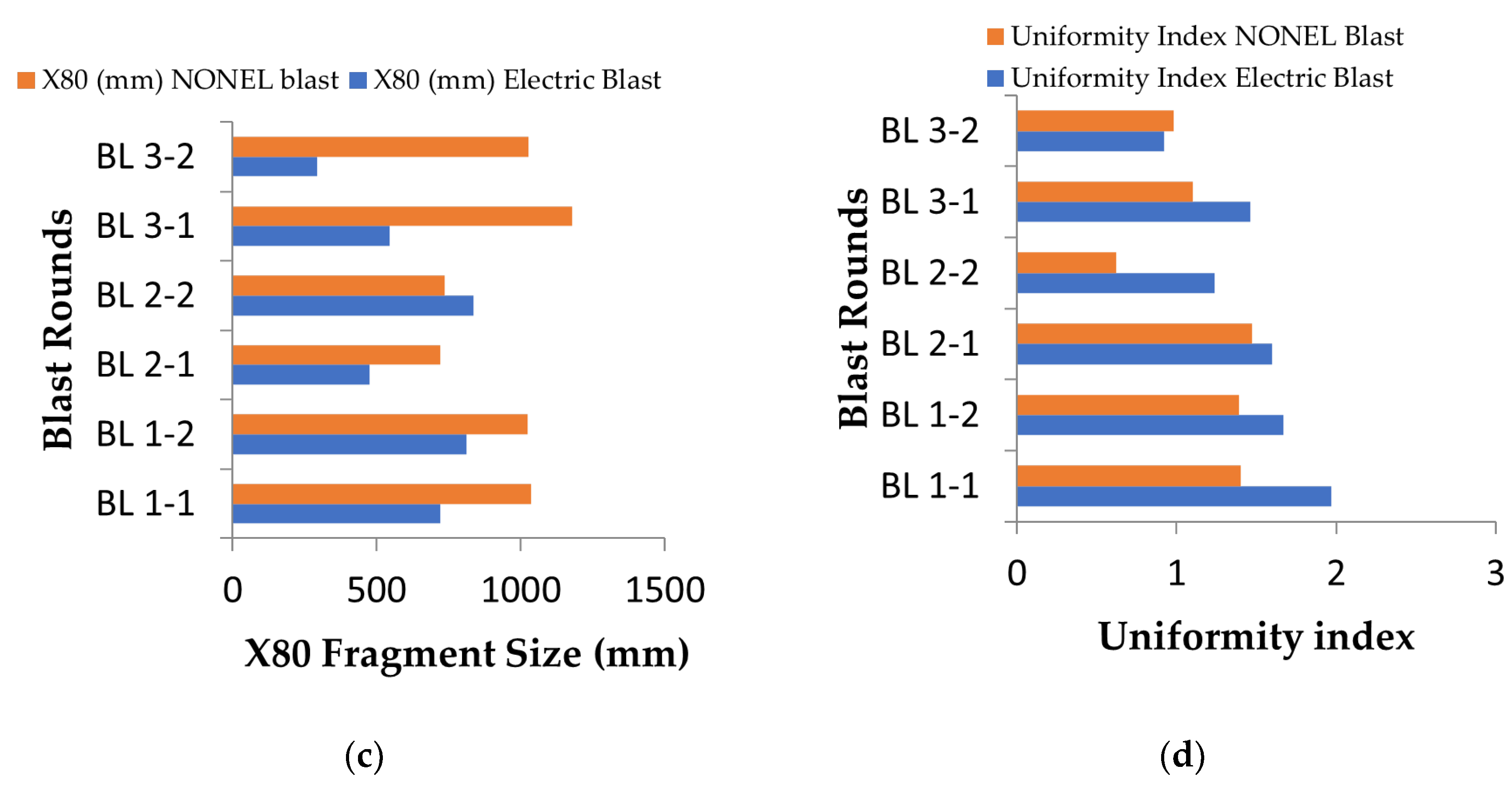
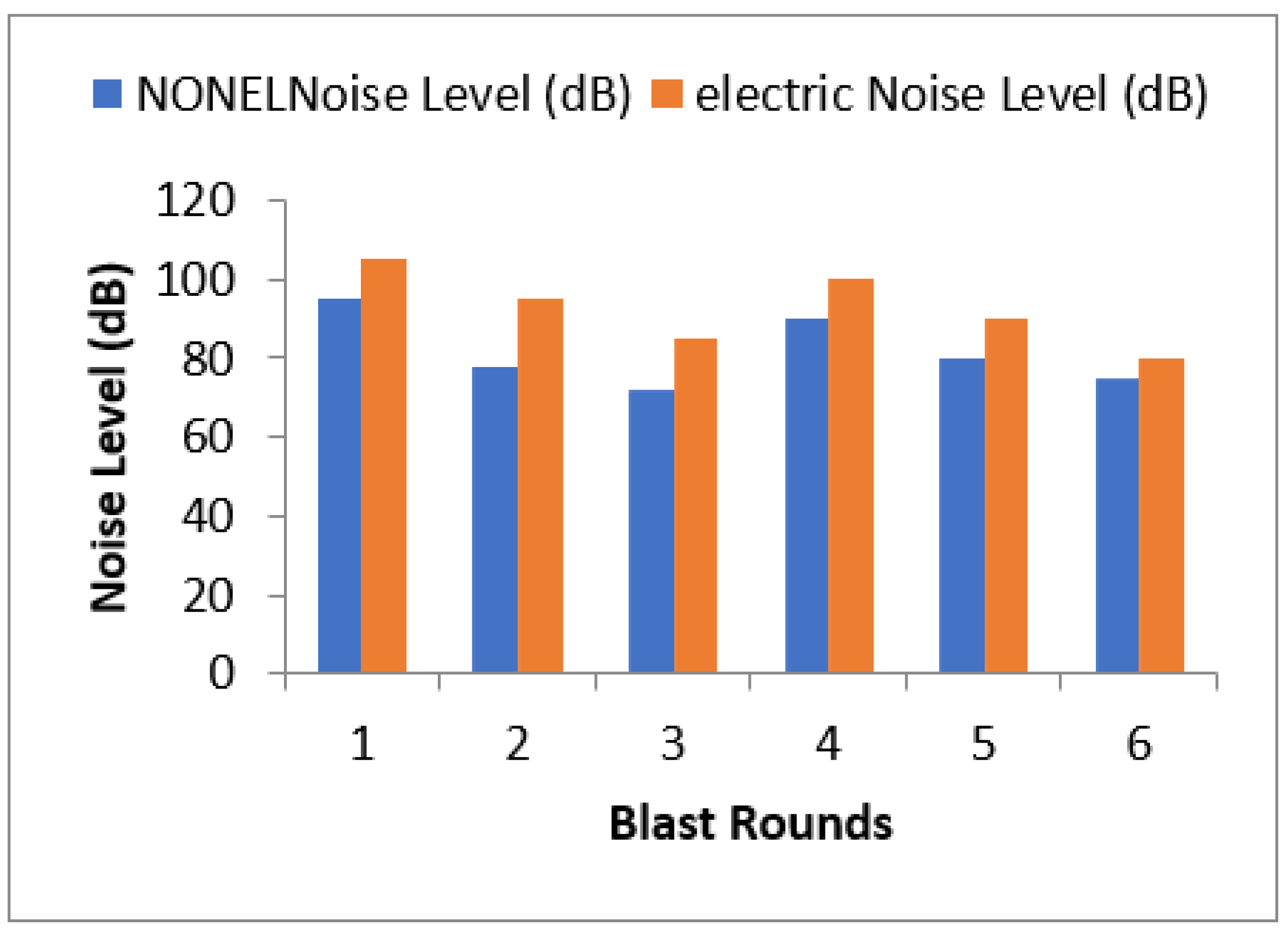
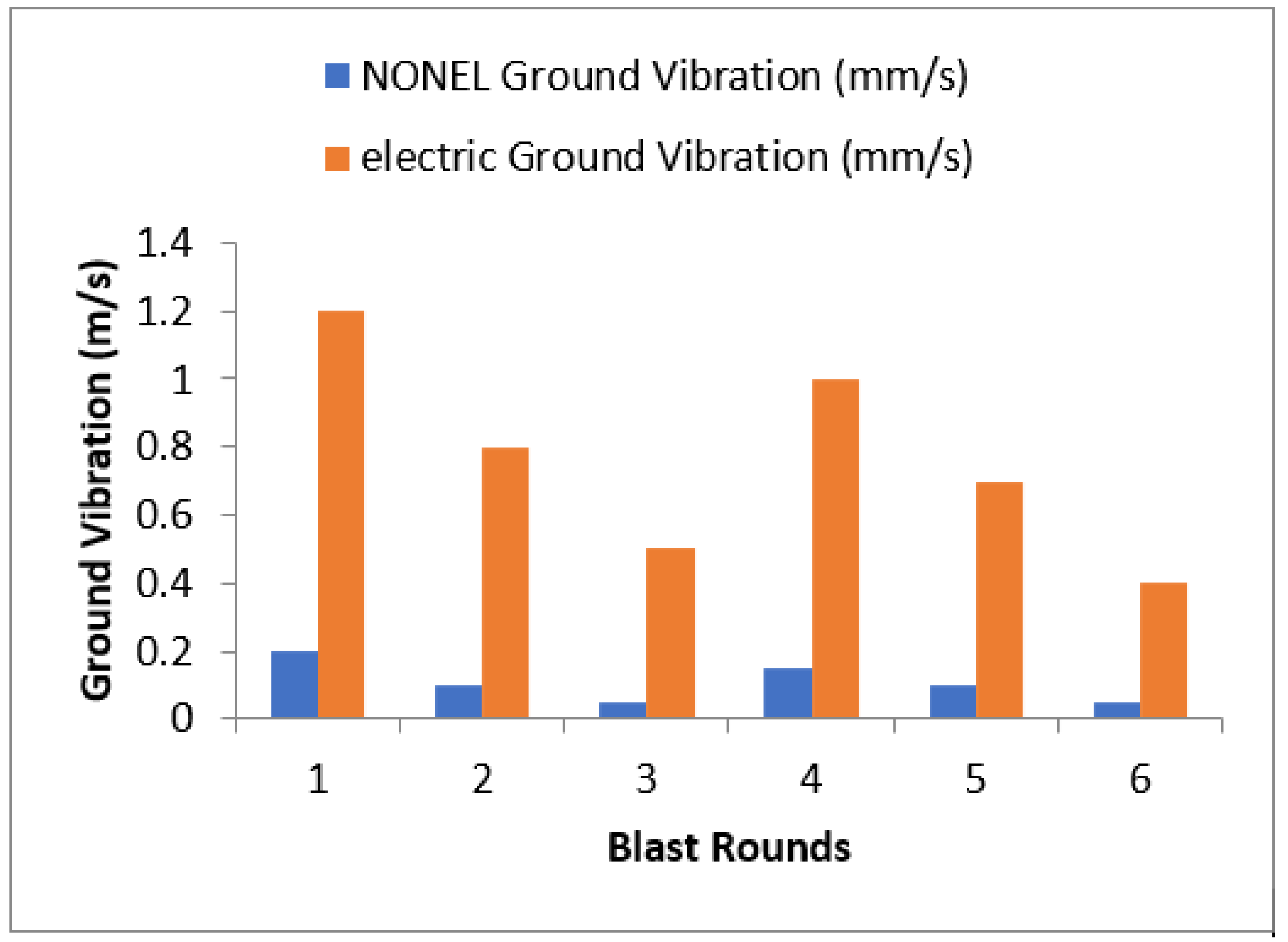
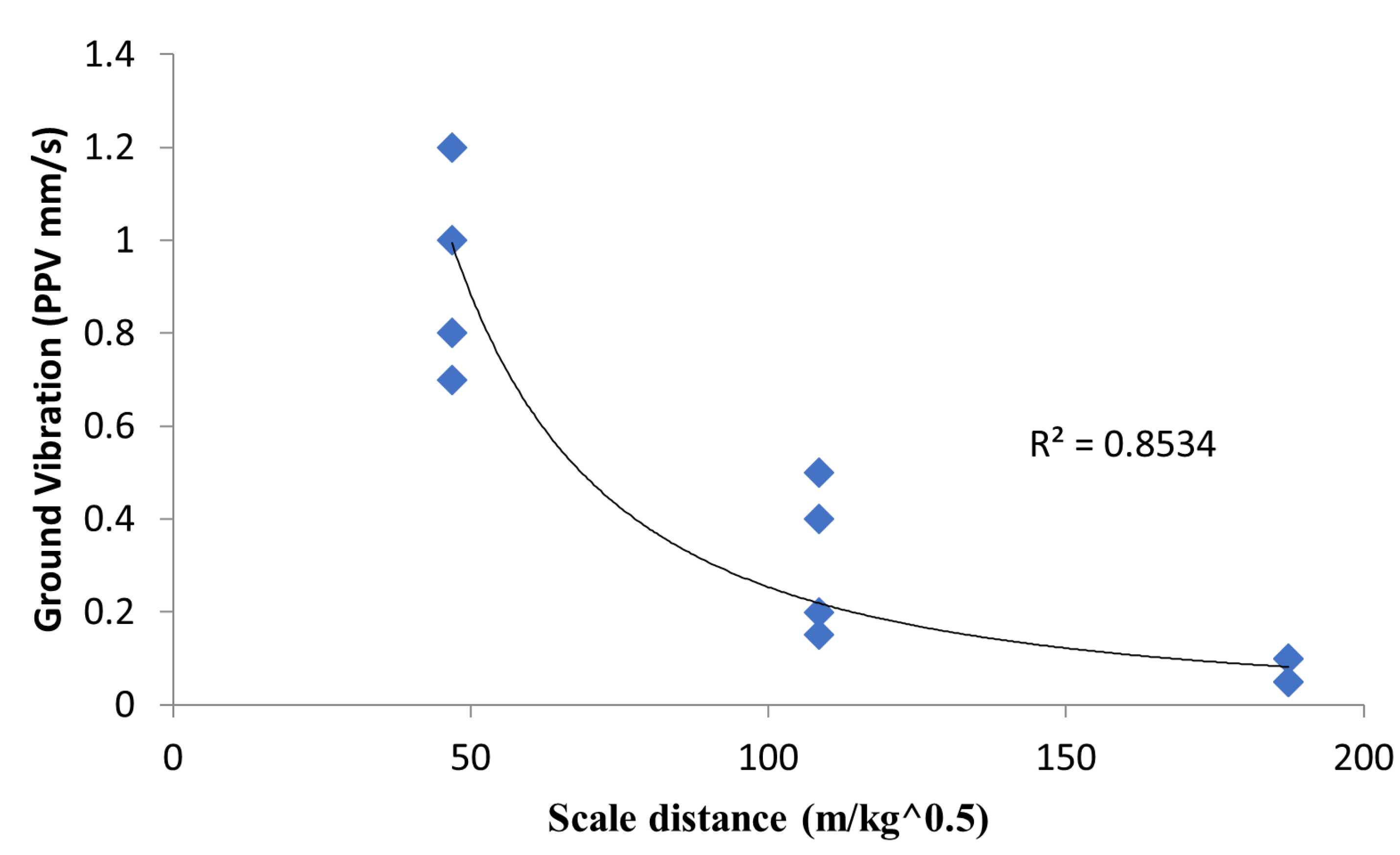
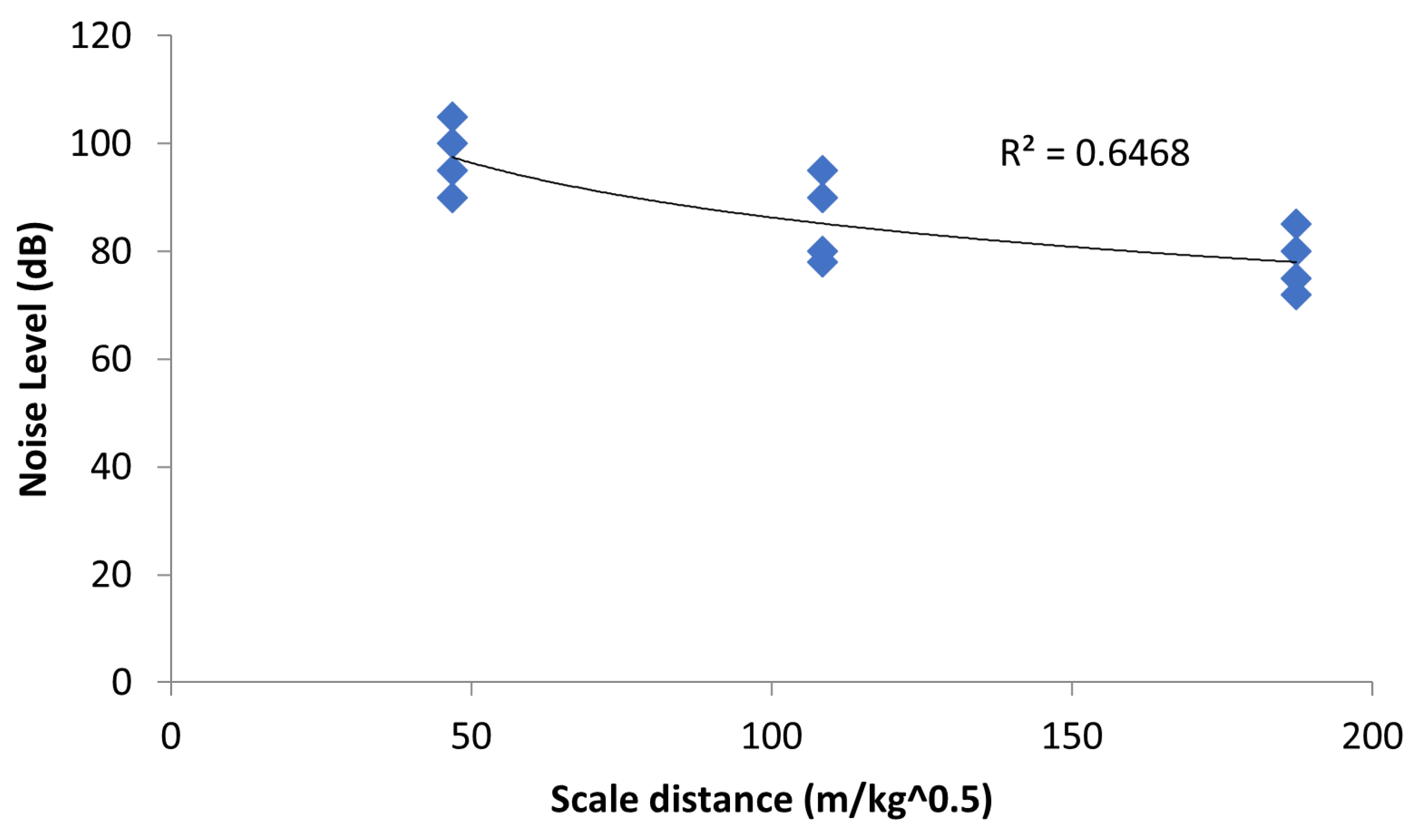

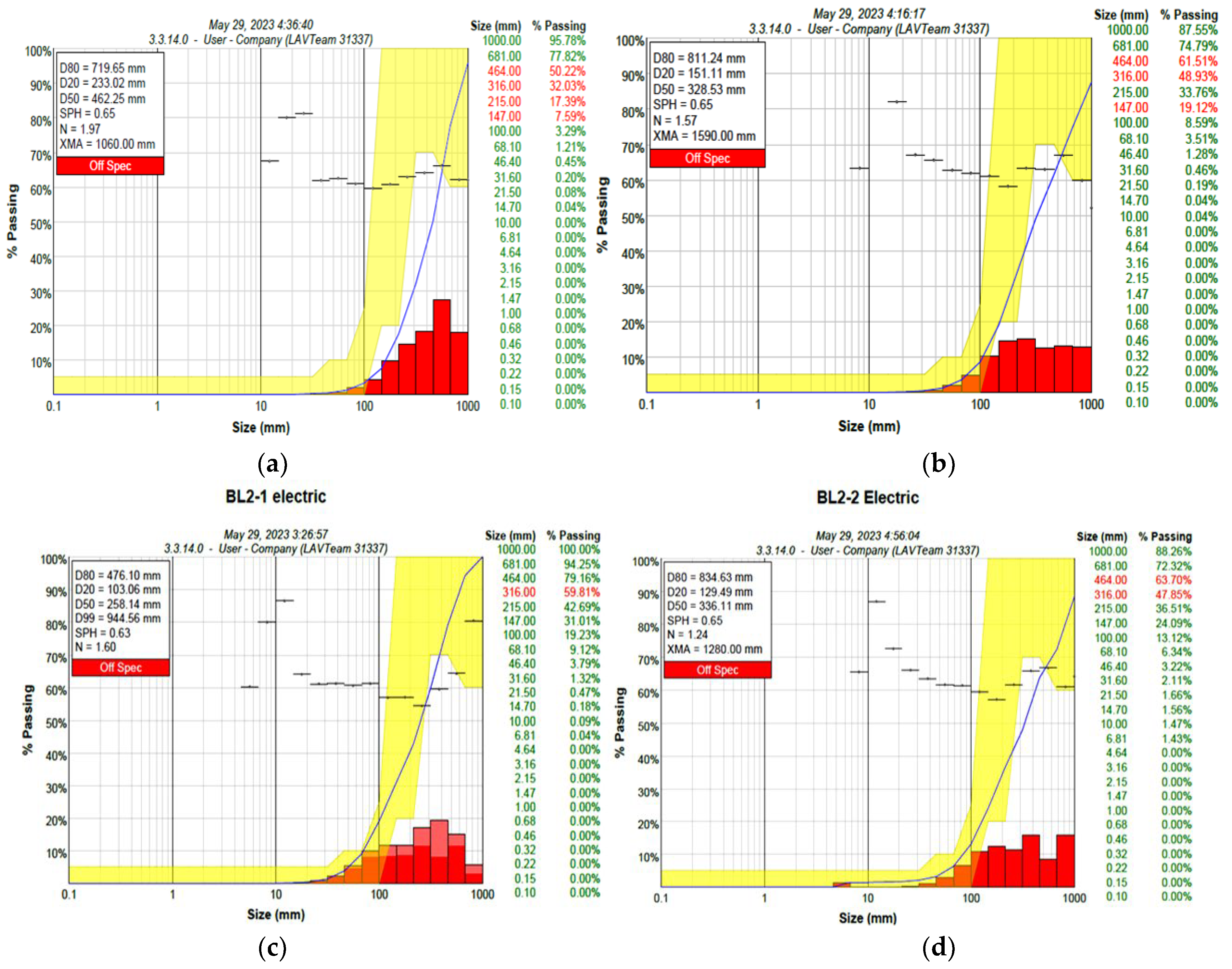

| Blast Parameter | Average Value |
|---|---|
| Burden (m) | 0.85 |
| Spacing (m) | 1.10 |
| Hole depth (m) | 1.35 |
| Average bench height (m) | 4.05 |
| Drill pattern | Staggered |
| Hole diameter (m) | 0.04 |
| Drill hole depth (m) | 1.35 |
| Stemming (m) | 0.66 |
| Subdrill (m) | 0 |
| Charge length (m) | 0.65 |
| Charge weight (kg) | 1.1 |
| Blast ID | Description | Number of Drill Holes |
|---|---|---|
| BL 1-1 | Image from nonelectric blast round one at pit 1 | 35 |
| BL 1-2 | Image from nonelectric blast round two at pit 1 | 56 |
| BL 2-1 | Image from nonelectric blast round one at pit 2 | 35 |
| BL 2-2 | Image from nonelectric blast round two at pit 2 | 56 |
| BL 3-1 | Image from nonelectric blast round one at pit 3 | 35 |
| BL 3-2 | Image from nonelectric blast round two at pit 3 | 56 |
| EL 1-1 | Image from electric blast round one at pit 1 | 35 |
| EL 1-2 | Image from electric blast round two at pit 1 | 56 |
| EL 2-1 | Image from electric blast round one at pit 2 | 35 |
| EL 2-2 | Image from electric blast round two at pit 2 | 56 |
| EL 3-1 | Image from electric blast round one at pit 3 | 35 |
| EL 3-2 | Image from electric blast round two at pit 3 | 56 |
| Size (mm) | BL 1-1 | BL 1-2 | BL 2-1 | BL 2-2 | BL 3-1 | BL 3-2 |
|---|---|---|---|---|---|---|
| 700 | 54.75 | 70.22 | 79.31 | 79.05 | 67.22 | 63.7 |
| 681 | 54.75 | 70.22 | 77.24 | 79.05 | 67.22 | 62.4 |
| 464 | 39.82 | 52.04 | 59.84 | 66.98 | 56.53 | 46.65 |
| 316 | 28.17 | 38.7 | 41.77 | 57.42 | 42.97 | 36.8 |
| 215 | 20.36 | 28.43 | 31.02 | 49.57 | 30.38 | 28.17 |
| 147 | 13.48 | 19.91 | 19.82 | 39.59 | 18.2 | 19.83 |
| 100 | 7.42 | 11.54 | 12.32 | 31.36 | 9.38 | 12.26 |
| 68.1 | 3.33 | 5.89 | 6.17 | 23.85 | 4.94 | 7.28 |
| 46.4 | 1.5 | 2.84 | 2.67 | 19.52 | 3.18 | 4.78 |
| 31.6 | 0.64 | 1.12 | 1.09 | 17.42 | 2.51 | 3.72 |
| 21.5 | 0.24 | 0.38 | 0.34 | 16.48 | 2.27 | 3.37 |
| 14.7 | 0.11 | 0.13 | 0.13 | 16.13 | 2.22 | 3.27 |
| 10 | 0.03 | 0.03 | 0.04 | 15.98 | 2.18 | 3.21 |
| 6.81 | 0 | 0 | 0 | 15.98 | 0 | 3.19 |
| 4.64 | 0 | 0 | 0 | 0 | 0 | 0 |
| 1.47 | 0 | 0 | 0 | 0 | 0 | 0 |
| 1 | 0 | 0 | 0 | 0 | 0 | 0 |
| Size (mm) | EL 1-1 | EL 1-2 | EL 2-1 | EL 2-2 | EL 3-1 | EL 3-2 |
|---|---|---|---|---|---|---|
| 1000 | 95.78 | 87.55 | 100 | 88.26 | 94.68 | 100 |
| 681 | 77.82 | 74.79 | 94.25 | 72.32 | 88.6 | 100 |
| 464 | 50.22 | 61.51 | 79.16 | 63.7 | 75 | 93.48 |
| 316 | 32.03 | 48.93 | 59.81 | 47.85 | 60.88 | 83.4 |
| 215 | 17.39 | 33.76 | 42.69 | 36.51 | 47.21 | 68.7 |
| 147 | 7.59 | 19.12 | 31.1 | 24.09 | 35.66 | 53.94 |
| 100 | 3.29 | 8.59 | 19.23 | 13.12 | 22.54 | 46.94 |
| 68.1 | 1.21 | 3.51 | 9.12 | 6.34 | 10.73 | 36.09 |
| 46.4 | 0.45 | 1.28 | 3.79 | 3.22 | 4.2 | 24.23 |
| 31.6 | 0.2 | 0.46 | 1.32 | 2.11 | 1.49 | 14.13 |
| 21.5 | 0.08 | 0.19 | 0.47 | 1.66 | 0.53 | 9.39 |
| 14.7 | 0.04 | 0.04 | 0.18 | 1.56 | 0.21 | 7.57 |
| 10 | 0 | 0.04 | 0.09 | 1.47 | 0.08 | 6.99 |
| 6.81 | 0 | 0 | 0.04 | 1.43 | 0.04 | 6.69 |
| 4.64 | 0 | 0 | 0 | 0 | 0 | 0 |
| 1.47 | 0 | 0 | 0 | 0 | 0 | 0 |
| Distance (m) | NONEL Noise Level (dB) | Electric Noise Level (dB) | NONEL Ground Vibration (mm/s) | Electric Ground Vibration (mm/s) | |
|---|---|---|---|---|---|
| 50 | 95 | 105 | 0.2 | 1.2 | |
| 100 | 78 | 95 | 0.1 | 0.8 | |
| 200 | 72 | 85 | 0.05 | 0.5 | |
| 50 | 90 | 100 | 0.15 | 1 | |
| 100 | 80 | 90 | 0.1 | 0.7 | |
| 200 | 75 | 80 | 0.05 | 0.4 | |
| Mean | 116.6667 | 81.66667 | 92.5 | 0.108333 | 0.766667 |
| StDev | 68.31301 | 8.959167 | 9.354143 | 0.058452 | 0.301109 |
| Variance | 4666.667 | 80.26667 | 87.5 | 0.003417 | 0.090667 |
Disclaimer/Publisher’s Note: The statements, opinions and data contained in all publications are solely those of the individual author(s) and contributor(s) and not of MDPI and/or the editor(s). MDPI and/or the editor(s) disclaim responsibility for any injury to people or property resulting from any ideas, methods, instructions or products referred to in the content. |
© 2023 by the authors. Licensee MDPI, Basel, Switzerland. This article is an open access article distributed under the terms and conditions of the Creative Commons Attribution (CC BY) license (https://creativecommons.org/licenses/by/4.0/).
Share and Cite
Taiwo, B.O.; Fissha, Y.; Palangio, T.; Palangio, A.; Ikeda, H.; Cheepurupalli, N.R.; Khan, N.M.; Akinlabi, A.A.; Famobuwa, O.V.; Faluyi, J.O.; et al. Assessment of Charge Initiation Techniques Effect on Blast Fragmentation and Environmental Safety: An Application of WipFrag Software. Mining 2023, 3, 532-551. https://doi.org/10.3390/mining3030030
Taiwo BO, Fissha Y, Palangio T, Palangio A, Ikeda H, Cheepurupalli NR, Khan NM, Akinlabi AA, Famobuwa OV, Faluyi JO, et al. Assessment of Charge Initiation Techniques Effect on Blast Fragmentation and Environmental Safety: An Application of WipFrag Software. Mining. 2023; 3(3):532-551. https://doi.org/10.3390/mining3030030
Chicago/Turabian StyleTaiwo, Blessing Olamide, Yewuhalashet Fissha, Thomas Palangio, Andrew Palangio, Hajime Ikeda, Nageswara Rao Cheepurupalli, Naseer Muhammad Khan, Adams Abiodun Akinlabi, Oluwaseun Victor Famobuwa, Joshua Oluwaseyi Faluyi, and et al. 2023. "Assessment of Charge Initiation Techniques Effect on Blast Fragmentation and Environmental Safety: An Application of WipFrag Software" Mining 3, no. 3: 532-551. https://doi.org/10.3390/mining3030030
APA StyleTaiwo, B. O., Fissha, Y., Palangio, T., Palangio, A., Ikeda, H., Cheepurupalli, N. R., Khan, N. M., Akinlabi, A. A., Famobuwa, O. V., Faluyi, J. O., & Kawamura, Y. (2023). Assessment of Charge Initiation Techniques Effect on Blast Fragmentation and Environmental Safety: An Application of WipFrag Software. Mining, 3(3), 532-551. https://doi.org/10.3390/mining3030030







